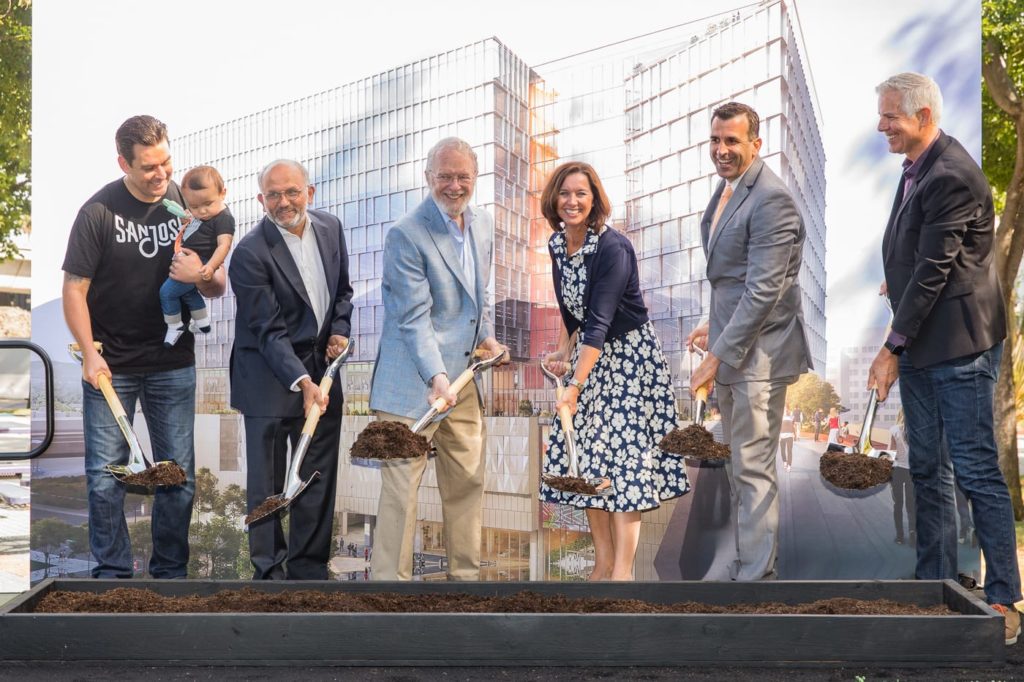When Adobe’s new office tower in downtown San Jose is complete in 2022, it will be completely electric, meaning it won’t use any fossil fuels like gas to operate, company leaders said Monday.
The announcement came as part of a ceremonial groundbreaking event for the company’s fourth San Jose office tower, called the North Tower. It will rise across the street from the San Jose-based design technology giant’s headquarters at 333 W. San Fernando.
“The North Tower is going to be… among the first of its kind in Silicon Valley, which is going to be pioneered by clean, renewable energy,” Adobe CEO Shantanu Narayen said. “Like the three [existing Adobe] towers behind us, it’s also going to be LEED certified.”

Adobe’s newest office tower is slated to be 18 stories tall with about 700,000 square feet of office space, several stories of parking and some ground-level retail space. About 4,000 Adobe workers will fit in the building, adding to the company’s current 3,500-person workforce in downtown San Jose today.
Eventually the company wants to shed its natural gas use in all of its real estate footprint, according to Vince Digneo, head of sustainability at Adobe.
“The way that I want to think about it is we want San Jose to have an emissions factor of zero,” he said after the groundbreaking Monday. “In other words, we’re delivering clean, renewable energy to everyone and including that building. And if it’s all electric, it can happen.”
But the shift for the company’s existing portfolio isn’t going to be easy, Digneo acknowledges. That’s why Adobe has set that renewable energy goal to be realized by 2035, a date that he thinks is a realistic timeline as building technologies continue to advance.
“What we would like to do is see our entire footprint removed of anything that consumes natural gas on site,” Digneo said. “That’s very difficult because fuel switching for a building that’s even 10 years old is … not all that economically feasible, but that’s the goal.”
Though most large development projects host groundbreaking ceremonies around the time construction gets underway, Adobe’s is a significant milestone for San Jose, marking the first office building to break ground in about a decade. The last project to be completed was the second Riverpark Towers building, which was built in 2009.
Today downtown San Jose is home to about 8.6 million square feet of office space, per city and brokerage data. That’s a relatively small amount of office space for a downtown in a city the size of San Jose, which is the largest municipality in the Bay Area.
But San Jose has a robust pipeline of office development proposals that could easily double the downtown’s office footprint in the coming years.
It’s perhaps fitting, however, that Adobe was the first to break the city’s downtown office development dryspell, considering its history in San Jose as the first major tech company to call the commercial business district home in the 1990s, after forays in both Mountain View and Palo Alto.
“In the early nineties, we decided that we had to move because we’d outgrown our facilities in Mountain View and we worked very closely with Tom McEnery and later with Susan Hammer,” Adobe founder John Warnock said Monday. “The city of San Jose was the most welcoming city that we were able to deal with and they were very generous and they helped us.”
San Jose Mayor Sam Liccardo on Monday praised Adobe for being among the first in Silicon Valley to break out of a trend of building “the corporate equivalent of gated communities” surrounded by parking in suburban parts of the region. Instead, he said, Adobe opted to build in a more urban area near transit and since then, downtown San Jose has attracted a robust list of more than 180 tech companies to downtown.
“Who would’ve thought that would’ve been possible a decade ago or two decades ago for that matter, and now we have wonderful billion-dollar companies, Zoom, Okta and many others here in downtown,” he said. “It all happened because Adobe decided ‘We’re going to do it first.’”
Contact Janice Bitters at [email protected] or follow @JaniceBitters on Twitter.



Leave a Reply
You must be logged in to post a comment.